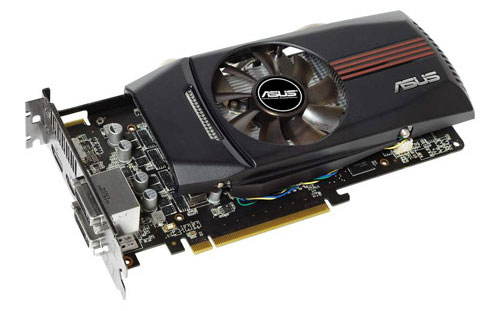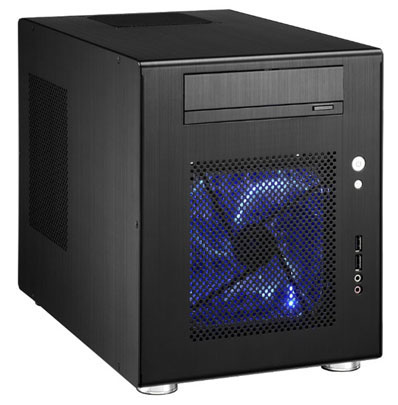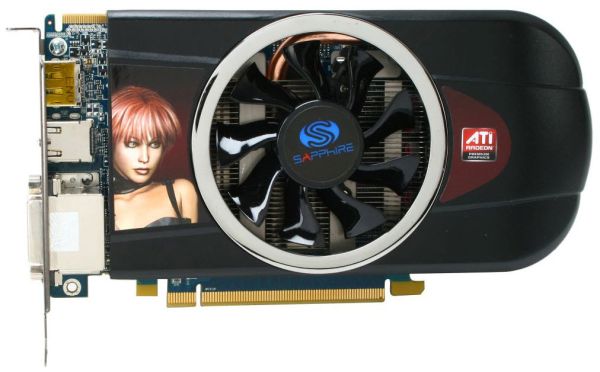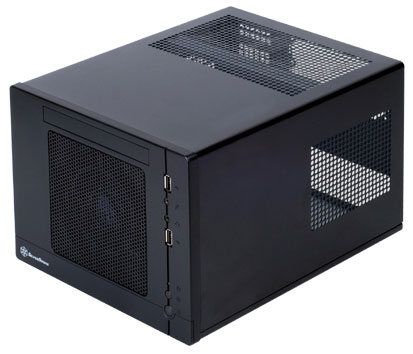Small Form Factor Buyers’ Guide
by Zach Throckmorton on May 25, 2011 10:30 AM ESTIntel Gaming SFF
Gaming rigs, with powerful CPUs and discrete GPUs, tend to produce more heat than standard desktops and HTPCs. Cramming the most power hungry components into a small space poses problems—problems that many newer SFF chassis obviate by getting a little bigger. Intel’s new Sandy Bridge CPUs are remarkably powerful while using relatively little juice. Similarly, AMD (ATI) GPUs tend to use less power under load than their NVIDIA competitors. Combine the two and it’s possible to assemble a nearly bleeding edge gaming rig in a slightly larger (13.6” x 9” x 10.8”) SFF system—and no, we aren’t going to put together a dual-GPU beast in the Silverstone FT03 chassis for this build, even if that is an option.
| Intel Gaming SFF | |||
| Component | Description | Cost | Rebate |
| Case | Lian Li PC-Q08B | $101 | |
| PSU | Antec TruePower New TP-550 | $90 | |
| CPU | Intel Core i5-2500K (4x3.3GHz, 3.7GHz Turbo, 8MB L3) | $216 | |
| Motherboard | ASUS P8H61-I | $85 | |
| GPU | ASUS EAH6850 DC/2DIS/1GD5/V2 Radeon HD 6850 | $155 | -$20 |
| Memory | Patriot 4GB (2x2GB) PSD34G1333K | $40 | |
| HDD | Samsung SpinPoint F3 HD103JS 1TB | $61 | |
| DVDRW | LITE-ON DS-8A5S | $33 | |
| OS | Windows 7 Home Premium 64-bit OEM | $100 | |
| Total Price | $881 | $861 | |
Note: The differences in case, PSU, and other components affect the total price.
If you compare with the AMD build, look at just the CPU, motherboard, and RAM.
Our Intel gaming SFF starts with the Core i5-2500K, a CPU that’s easily capable of running all the latest games (with an appropriate GPU). It uses very little power at idle and is an all around excellent chip. While it’s not quite as potent as the Core i7-2600K (thanks to the lack of Hyper-Threading), it also dissipates less

heat, making it a perfect fit for an SFF. Besides, if you’re planning on gaming and you’ll only be using a single GPU, particularly at higher resolutions there’s very little advantage to getting a faster CPU.
The AMD Radeon HD 6850 is a good match for the i5-2500K. Like the CPU, the 6850 isn’t the fastest GPU, but it’s plenty powerful and capable of playing the latest titles at 1080p and high detail settings at acceptable framerates. The 6850 is slightly slower than the previous generation 5850 (10% or less on almost all benchmarks), but it uses less power and its power connectors are better positioned (on the side vs. on the end) for use in an SFF case. It’s also about the longest video card that will fit in a mini-ITX chassis. At 10.27” in length, it fits inside the Lian Li PC-Q08B with a small amount of breathing room.
Speaking of which, I absolutely love the PC-Q09B case. It’s  somewhat large for a mini-ITX SFF chassis, but its airflow and cooling potential are very good and it can accommodate multiple 3.5” hard drives as well as a standard optical drive and PSU. For this build, we recommend a 1TB Samsung SpinPoint F3 HDD. Once you start installing games, an SSD will quickly run out of space, though you can always go the SSD + HDD combination if you choose. (We’d recommend at least a 60GB SSD, just because games periodically store additional files on the C: drive.) If you have the money, you could also get a larger 120GB SSD for the OS and apps and install a handful of favorite titles there, with any others relegated to the HDD.
somewhat large for a mini-ITX SFF chassis, but its airflow and cooling potential are very good and it can accommodate multiple 3.5” hard drives as well as a standard optical drive and PSU. For this build, we recommend a 1TB Samsung SpinPoint F3 HDD. Once you start installing games, an SSD will quickly run out of space, though you can always go the SSD + HDD combination if you choose. (We’d recommend at least a 60GB SSD, just because games periodically store additional files on the C: drive.) If you have the money, you could also get a larger 120GB SSD for the OS and apps and install a handful of favorite titles there, with any others relegated to the HDD.
Wrapping up our Intel Gaming SFF, I find modular PSUs work best in the PC-Q08B, as cable management is easier because there are fewer cables immediately adjacent to the hard drive cage. The Antec TP-550 is 80 Plus Bronze certified and has a few fixed cables with the rest being modular. If you prefer an alternative, the Seasonic M12II 520W is fully modular and 80 Plus Bronze certified. Both PSUs are very good quality and are more than sufficient wattage to power the components we selected. Just to be clear, the Antec and Seasonic PSUs (as well as other modular PSUs) are a very tight fit against the top drive cage, but with some patience, they will work.
AMD Gaming SFF
Like the HTPC segment, AMD does not currently offer any CPUs that can compete with the Intel offerings in terms of both performance and power consumption. Instead, AMD relies on cost to remain competitive. This AMD gaming system is not as powerful as the Intel system, but it costs a lot less. Here’s what we selected for this build.
| AMD Gaming SFF | |||
| Component | Description | Cost | Rebate |
| Case | Silverstone Sugo SG05-B | $105 | |
| CPU | AMD Athlon II X3 450 (3x3.2GHz, 3x512K L2) | $76 | |
| Motherboard | ASUS M4A88T-I Deluxe | $125 | |
| GPU | Sapphire 100283-3L Radeon HD 5770 | $115 | -$20 |
| Memory | Patriot 4GB (2x2GB) PSD34G1066SK SO-DIMMs | $44 | |
| HDD | Western Digital Caviar Blue WD5000AAKS | $45 | |
| DVDRW | LITE-ON DS-8A5S | $33 | |
| OS | Windows 7 Home Premium 64-bit OEM | $100 | |
| Total Price | $643 | $623 | |
| AMD Gaming Alternatives (Downgrades) | |||
| CPU | AMD Athlon II X2 250 (2x3.0GHz, 2x1MB L2) | $61 | |
| GPU | Sapphire 100287VGAL Radeon HD 5670 | $70 | -$10 |
| Total Price with Downgrade | $583 | $573 | |
Note: The differences in case, PSU, and other components affect the total price.
If you compare with the Intel build, look at just the CPU, motherboard, and RAM.
AMD’s Athlon II X3 450 offers tremendous value for the budget-conscious gamer; it uses less power than its

Black Edition Phenom II and quad-core relatives and only costs $15 more than the dual-core X2 250 we’ve recommended twice now. Matched with a Radeon HD 5770, you’ve got a very capable gaming system. At less than $100 after rebate, the Radeon HD 5770 offers astonishing value to gamers on a budget. The 5770 may not seem like much compared to other desktop GPUs, but keep in mind that this venerable GPU would rank near the top of the mobile GPU heap—it has the same number of GPU cores and is clocked higher than the Mobility HD 5870. So if you’re curious about the gaming potential, it would be roughly equal to the GTX 460M notebooks we’ve looked at recently, at less than half the price.
The Silverstone Sugo SG05-B mini-ITX chassis includes an 80 Plus certified 300W PSU. This case doesn’t have quite the airflow  potential of the Lian Li recommended above, and it’s also noisier because of the plastic construction, but it’s still a very good case. It’s also smaller at 10.9” x 8.8” x 7”. The SG05-B can house one 2.5” SSD and one 3.5” HDD, but since this is a budget build, we’re going with one 500GB Western Digital Caviar Blue mechanical HDD to keep costs down. As always, you can go with a larger capacity hard drive if necessary, and you can certainly add an SSD later if you’re interested. The case also supports a slim optical drive, so we chose a DVDRW to fill that role.
potential of the Lian Li recommended above, and it’s also noisier because of the plastic construction, but it’s still a very good case. It’s also smaller at 10.9” x 8.8” x 7”. The SG05-B can house one 2.5” SSD and one 3.5” HDD, but since this is a budget build, we’re going with one 500GB Western Digital Caviar Blue mechanical HDD to keep costs down. As always, you can go with a larger capacity hard drive if necessary, and you can certainly add an SSD later if you’re interested. The case also supports a slim optical drive, so we chose a DVDRW to fill that role.
Recommended Gaming SFF
Many popular games like StarCraft 2 and World of WarCraft have very modest hardware requirements for enjoyable gaming, especially at lower resolutions and/or detail settings. You could shave an additional $50 or so off the cost of the AMD system by using an Athlon II X2 250 CPU and Radeon HD 5670 GPU instead of the Athlon II X3 450 and Radeon HD 5770. You can see how the Athlon II X3 450 compares with Athlon II X2 255 in our CPU Bench; the 255 is about 3% faster than the 250, so you’re not missing out on much. Similarly, you can see how the 5770 compares to the 5670 in our 5670 review. The 6850 is quite a bit faster, of course, so if you can spare the extra $40 the ASUS 6850 in the Intel system will prove beneficial.
Our SFF Gaming rigs represent opposite ends of the budget spectrum, with the Intel system costing almost 50% more than the AMD system. The Intel system is certainly more capable, but if we remove all the other component differences from the table, the actual cost for the Intel SFF (CPU, motherboard, and RAM) is just under $100. If you only have a modest budget, the AMD system will suffice—you can also see how the two CPUs stack up in our CPU Bench. The AMD CPU may be inferior to the Intel CPU, but pay particular attention to the gaming performance, where the AMD triple core chip still turns out acceptable frame rates. Likewise, the Radeon HD 5770 isn’t as powerful as the Radeon HD 6850, but as you can see in GPU Bench, the cheaper GPU is still quite capable.










71 Comments
View All Comments
chaoticlusts - Wednesday, May 25, 2011 - link
you could have a look on the freenas forums and such if your curious, I've built a freenas box though it's not small cause I wanted to be able to put a lot of HDD's in there (got 8 atm)requirements vary drastically depending on what your doing with it, if your running a RAID setup then there's bugger all requirements really...but if your going with FreeNAS you really should be running ZFS in which case you need a little bit of cpu power (though still a low budget celeron or similar is fine, just don't reuse and old single core that might be pushing it) actually in the end you can get bottom range components for basically everything the couple of bits you should *not* skimp on is PSU (never skimp on that) get a decent amount of RAM (4-8GB) doesn't need to be fast though just a decent quantity and obviously get the case your happy with..
FreeNAS can be a bit of a headache to find your way around if your not used to FreeBSD or similar but once you learn it's damn easy and saves you *tons* of money over a dedicated NAS box (not to mention ZFS is far superior to standard RAID) I think my box cost me about 300-400 total not including HDDs....a 8 drive dedicated NAS would probably cost a few grand normally without HDD's...
course this does all depend on how much storage you need..like people pointed out...if you only need a little a NAS might be overkill :)
2korda2 - Thursday, May 26, 2011 - link
+1 on that.Been looking at Synology 411 series, but not sure the J-series is enough. '+' costs a lot more.
JFish222 - Saturday, May 28, 2011 - link
I have to agree. I would love to see this discussed.While there are a number of inexpensive NAS appliances out there, there is only so much you can do at the lower price points(based around arm cores).
Having advnaced media streaming/transcoding, wan side access (even providing vpn support) etc are where custom boxes pay off.
Expecially if you want more than 2 HD's or want to push hardware RAID 5 (cheap adaptec cards on ebay "raid adaptec sata" < $20)
The only issues become time and effort. Would never knock an off the shelf system, but I'm far to interested in going beyond what an ARM core can offer at a price point I'm able to afford.
Though I'm still researching, projects like Amahi are attempting to make this even more of a "user friendly" process.
chrone - Wednesday, May 25, 2011 - link
really love this SFF part, unfortunately there's very limit component choice sold here in indonesia. :(StanFL - Wednesday, May 25, 2011 - link
I built a WHS box based on the Apex case used in the Budget SFF. Dual core Atom mini ITX board with four SATA ports. By foregoing an optical drive, I shoehorned three 3.5" hard drives in it. I can add a fourth hd if necessary with a Esata bracket occupying the lone expansion slot. It's a nice little low power box thats been running 24/7 for nearly a year now.EddyKilowatt - Wednesday, May 25, 2011 - link
Same here, WHS on Atom mobo (from Intel) in the Apex case. 18 watts at idle. Just two 1 TB green drives for me though... so far they're about half full.I didn't expect full benchmarks on each build in this article, but a couple of basic numbers and an idle/loaded power reading from a Kill-A-Watt would've been nice. Great article anyway, though, keep 'em coming.
Shadowmaster625 - Wednesday, May 25, 2011 - link
I have a sempron 140 running at 800 MHz @ 1.1V. The cheapo $20 motherboard I am using will not let me take the volts any lower... But anyway the point is this thing surfs the web and plays youtube videos just fine. It has no fan. I took the fan off the stock hsf. I ran rthdribl all day long and the core temp reads just 68. lol. The main cpu thermal sensor reads 52.dagamer34 - Wednesday, May 25, 2011 - link
I recently built a SFF HTPC and this was my setup:Case: Thermaltake Element Q case w/ 220W PSU: $70 from Micro Center
CPU: Intel Core i3-2100: $99 from Micro Center
Motherboard: Gigabyte H67-USB3-B3: $110
Video Card: AMD Radeon HD 6570 1GB DDR3: $70 from Amazon
Memory: 4GB Corsair DDR3 1333Mhz RAM (CMX4GX3M1A1333C9): $41 from Amazon
SSD: OCZ Vertex 2 60GB: $110 from Micro Center
HDD: old 120GB HD from Apple MacBook Pro
AMS Dual SATA Enclosure (DS-112SSBK): $20 from Newegg
Antec Veris Elite IR Receiver: $59 from Amazon
OS: TechNet Subscription
I got a separate video card because of all the post-processing that the card can do, as well as correctly outputting 23.976 fps video.
I'd also argue that any serious HTPC needs to have the cost of an IR dongle included. No one should be using a mouse and keyboard.
StormyParis - Wednesday, May 25, 2011 - link
I really think the review would be a lot more informative if you did two things:1- differentiate by function: Netttop, NAS, HTPC, Gaming. You're kinda doing it now, but still not fully.
2- include ready-made PCs, and give more choices for components.
Case in point: I recently replaced my micro-ATX rig with 2 mini-itx ones:
- a NAS/ HTPC, in an ElementQ case with an aftermarket PSU. This allows 3x3.5" HDs, one can be a DVD/BR instead, in the size of a shoe box.
- a VESA-mounted Nettop in an M350 case. (T-3410 would have been much cheaper)
Both with the Asus passive E-350 motherboard, which is surprisingly adept in the nettop: it drives 2 screens, one can run full-screen SD video while I play Civ4 on the other.
I think you're going overboard with the CPU power, too, except for the gaming rig.
vnangia - Wednesday, May 25, 2011 - link
Wouldn't something like the PC-Q08 be a better choice for a NAS? That plus either the Zotac H55/H67 or DTX D510 gives you the ability to put in six drives easily stock, and possibly eight with a cheap addon card and a 5.25-3.5 adapter.